Trees Birds Mammals Fish Amphibians Reptiles
Wild Algarve
Bookshop
Clavulinopsis laeticolor (Berk. & M.A. Curtis) R.H. Petersen - Handsome Club
Phylum: Basidiomycota - Class: Agaricomycetes - Order: Agaricales - Family: Clavariaceae
Distribution - Taxonomic History - Etymology - Identification - Reference Sources
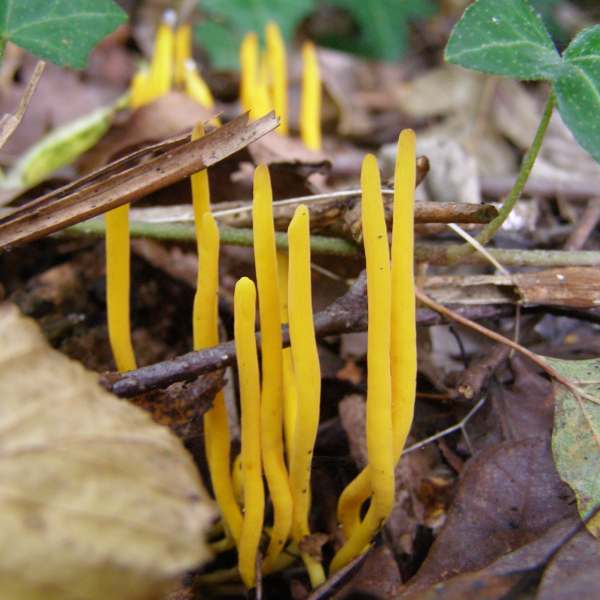
One of several very similar yellow or orange club fungi, this club can be found on leaf litter in damp deciduous woodland or occasionally in hedgerows. Although the Handsome Club is most often found in woodlands, it also occurs in some unimproved grassland, heath and moorland habitats.
Confident identification of yellow or orange fairy clubs from macroscopic characteristics alone is not generally feasible; microscopic characteristics have to be examined to confirm the identity of many of these superficially very similar club fungi.
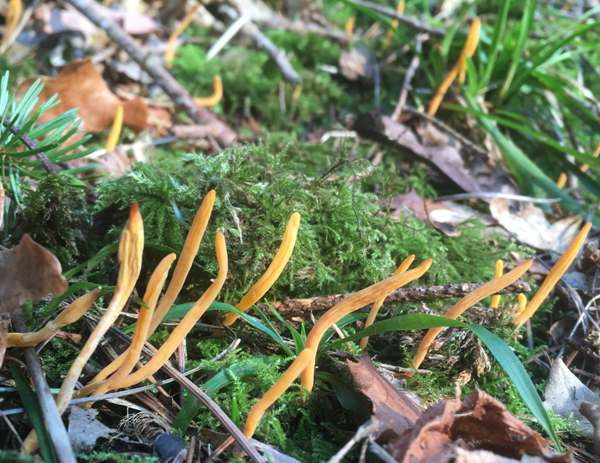
Distribution
In Britain and Ireland Handsome Club is fairly common. It also occurs on mainland Europe and in other parts of the world including North America.
Taxonomic history
This fairy club fungus was described in 1799 by English botanist Miles Joseph Berkeley and New Zealander Moses Ashley Curtis (1808 - 1872), who gave it the binomial scientific name Clavaria laeticolor. It was not until 1965 that the currently accepted scientific name Clavulinopsis laeticolor arose, when American mycologist Ronald H Petersen (born 1934) transferred this species to the genus Clavulinopsis.
Synonyms of Clavulinopsis laeticolor include Clavaria laeticolor Berk. & M.A. Curtis, Clavaria pulchra Peck, Clavaria persimilis Cotton, Clavulinopsis pulchra (Peck) Corner, and Clavulinopsis laeticolor f. bulbispora R.H. Petersen.
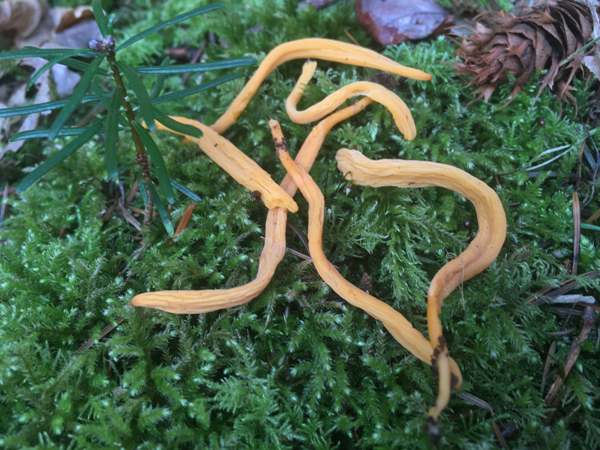
Etymology
The origin of the generic name is the Latin noun clava meaning a club, with the suffix implying that it looks quite similar to species in the genus Clavulina. The Clavulinopsis genus is closely related to Clavulina and Clavaria, but fungi in the Clavulinopsis group have tougher, less brittle fruitbodies that are solid rather than hollow in structure. The most obvious microscopic difference is that Clavulinopsis species have clamp-connections in the tramal tissues.
The specific epithet laeticolor also comes from Latin and means 'of a joyous colour' - in other words, pretty, I guess. That may not be the most descriptive of adjectives, but a photogenic group of these fairly clubs certainly is a joy to behold.
Identification Guide
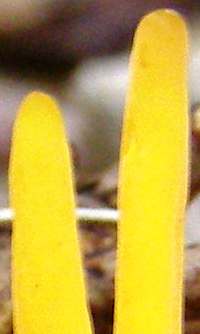 |
Fruitbody
Usually clustered but not often fused at the base; rarely branched; straight or only slightly curved; sometimes flattened in cross-section; tips either obtuse, spatulate, or very occasionally pointed; tapering toward the base; surface smooth, yellow-orange to orange, paler near the base.
The individual clubs are typicaly 2 to 5cm tall and 1.5 to 3mm diameter. |
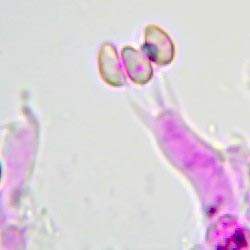 |
Fertile surface
Basidia, on the upper part of the clubs, are four spored.
|
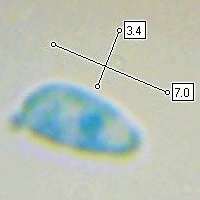 |
Spores
Broadly ellipsoidal or subglobose, smooth, 5.5-8 x 3.5-5.5µm; with a prominent offset apiculus (where the spore was originally attached to the basidium) 1.5 to 2 µm in length.
Spore print
White. |
Odour/taste |
Not distinctive. |
Habitat & Ecological role |
Saprobic, growing from leaf litter in damp woodland; very occasionally also in grassland habitats. |
Season |
July to November in Britain and Ireland. |
Similar species |
Clavulinopsis luteoalba, the Apricot Club, forms dense tufts of clubs that are lateraly compressed and sometimes forked. |
Reference Sources
Fascinated by Fungi, 2nd Edition, Pat O'Reilly 2016, reprinted by Coch-y-bonddu Books in 2022.
Dictionary of the Fungi; Paul M. Kirk, Paul F. Cannon, David W. Minter and J. A. Stalpers; CABI, 2008
Taxonomic history and synonym information on these pages is drawn from many sources but in particular from the British Mycological Society's GB Checklist of Fungi.
Acknowledgements
This page includes pictures kindly contributed by Simon Harding.
Top of page...
Fascinated by Fungi. Back by popular demand, Pat O'Reilly's best-selling 450-page hardback book is available now. The latest second edition was republished with a sparkling new cover design in September 2022 by Coch-y-Bonddu Books. Full details and copies are available from the publisher's online bookshop...